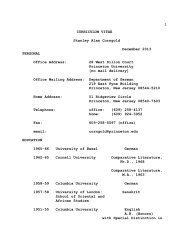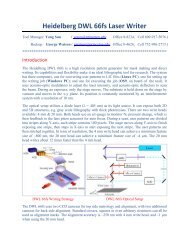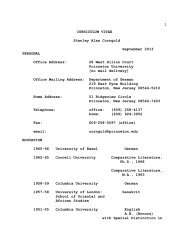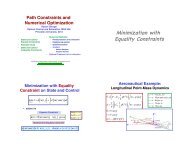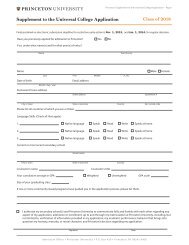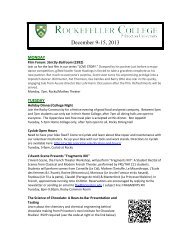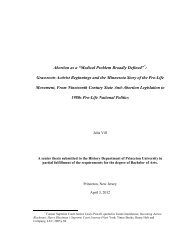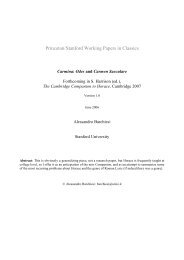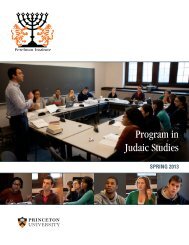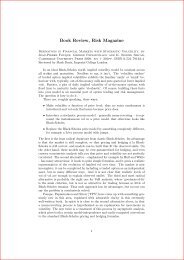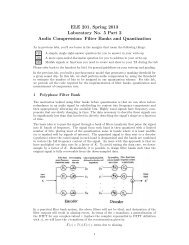Option-Implied Currency Risk Premia - Princeton University
Option-Implied Currency Risk Premia - Princeton University
Option-Implied Currency Risk Premia - Princeton University
Create successful ePaper yourself
Turn your PDF publications into a flip-book with our unique Google optimized e-Paper software.
(Specification I) reproduces the relation exactly, with a coefficient estimate of -0.46 (t-stat: -3.06). In contrast,<br />
once loadings have been perturbed by Ψ ∗ – in order to match the historical point estimate of the mean return on<br />
the empirical factor mimicking portfolio for the HML F X factor – the relation becomes statistically insignificant,<br />
with a point estimate of -0.03 (t-stat: -0.20).<br />
The intuition from skewness regressions is similar in spirit. In the data, the relation between the optionimplied<br />
skewness and the interest rate differential is weakly negative, with a point estimate between -0.89 (t-stat:<br />
-1.66) and -1.21 (t-stat: -1.81). Unsurprisingly, the value of the coefficient here is more sensitive to the details<br />
of the implied volatility extrapolation scheme used to compute the value of the option-implied skewness. Our<br />
preferred calibration produces a noticeably stronger link, with a point estimate of -6.66 (t-stat: -3.35). This link<br />
is strengthened even further once the model is forced to match historical risk premia (Ψ ∗ > 0), raising the point<br />
estimate to -12.41 (t-stat: -6.20). Once again, we find that inducing strong covariation between loadings and<br />
interest rate differentials, pushes the relation between model-implied exchange rate moments and interest rate<br />
differentials further away from that observed in the data.<br />
4.2 Do global factor loadings depend on Y i<br />
t ?<br />
Within the model, the dynamics of FX option prices and interest rates, (5), are driven by the global and<br />
country-specific state variables. In Panel B of Table VI, we examine the existence of this relationship by regressing<br />
the change in the one-month interest rate onto terms governing the model-implied change, ∆ ( −k g [ ] )<br />
t −ξ<br />
i<br />
t · Zt<br />
and ∆ ( −kt i [−1] · Yt<br />
i )<br />
. Notice that while this regression is the closest proxy to our model, it suffers from omitted<br />
variable bias due to the absence of an empirical proxy for α i t. We find that the country-level regressions<br />
consistently point to the absence of a link between interest rates and the state variables extracted from foreign exchange<br />
options. The p-values of the joint test that the coefficients on the model-implied variables are equal to one<br />
strongly rejects the model within each country. This negative result leaves open the possibility that linking global<br />
factor loadings to the Y i<br />
t<br />
state variables directly, rather than interest rate differential, may generate the desired<br />
increase in risk premia for models with time-varying loadings. As mentioned earlier, this type of parametrization<br />
is explicitly built into the “unrestricted” model of Lustig, et al. (2011).<br />
We repeat the calibration of our preferred model specification, allowing global factor loadings to be tied<br />
to local state variable dynamics via ξt<br />
i = ξ i − ˜Ψ t · (Y<br />
t i − Yt<br />
US )<br />
. Similar to the parametrization based on<br />
interest rate differentials, this expression normalizes the U.S. loading to equal ξ US at each point in time, which<br />
is set equal to one. Repeating the calibration of our preferred specification, we find that the mean value of<br />
˜Ψ t in the time series is -0.37 (t-stat: -1.84). The RMSE of the option fitted error is 1.05, which is slightly<br />
35



